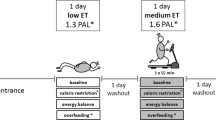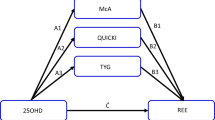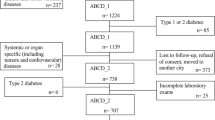Abstract
Background & aims
Metabolic flexibility (MetF) is considered a metabolic health biomarker, as excess body weight is associated with lower MetF. We aimed to identify whether MetF indexes were associated with cardiometabolic risk factors before and after adjustment for body size-related factors (body weight, fat-free mass, and resting metabolic rate).
Methods
We studied 51 participants (55% women; 33.6 ± 8.7 years; 26.3 ± 3.8 kg/m²) who consumed a 75-g glucose load. We measured gas exchange before (fasting) and for 3 h after glucose ingestion. MetF indexes were assessed, including the change after each hour and the 3-hour incremental area under the curve (iAUC) in respiratory exchange ratio (RER). These indexes were then related to cardiometabolic risk factors before and after adjusting for body size-related factors.
Results
MetF indexes correlated with each other (r ≥ 0.51; P < 0.001) and related to body weight (adjusted R2 ≥ 0.09; P < 0.03). A similar pattern was noted for fat-free mass and resting metabolic rate. MetF, regardless of the index, was not related to cardiometabolic risk factors except to BMI and high-density lipoprotein-cholesterol (HDL-C). The association between BMI and MetF disappeared after adjusting for body size-related factors. Similar adjustments did not modify the association between HDL-C and MetF, especially when approached by the change in RER after the first hour (adjusted R2 = 0.20–0.22; all P < 0.02).
Conclusions
Inter-individual body size differences fully accounted for the associations between BMI and MetF. However, variability in body size-related factors appeared less relevant in affecting the associations of other cardiometabolic risk factors with MetF.
This is a preview of subscription content, access via your institution
Access options
Subscribe to this journal
Receive 12 print issues and online access
$259.00 per year
only $21.58 per issue
Buy this article
- Purchase on Springer Link
- Instant access to full article PDF
Prices may be subject to local taxes which are calculated during checkout



Similar content being viewed by others
Data availability
Additional data are available from the corresponding author on reasonable request.
References
Frayn KN. Integration of substrate flow in vivo: some insights into metabolic control. Clin Nutr. 1997;16:277–82. https://doi.org/10.1016/S0261-5614(97)80012-X.
Samra JS, Clark ML, Humphreys SM, Macdonald IA, Frayn KN. Regulation of lipid metabolism in adipose tissue during early starvation. Am J Physiol 1996;271. https://doi.org/10.1152/AJPENDO.1996.271.3.E541.
Galgani JE, Gómez C, Mizgier ML, Gutierrez J, Santos JL, Olmos P, et al. Assessment of the role of metabolic determinants on the relationship between insulin sensitivity and secretion. PLoS One. 2016;11:1–16. https://doi.org/10.1371/journal.pone.0168352.
Galgani JE, Fernández-Verdejo R. Pathophysiological role of metabolic flexibility on metabolic health. Obes Rev. 2021;22:1–14. https://doi.org/10.1111/obr.13131.
Kardinaal AFM, Van Erk MJ, Dutman AE, Stroeve JHM, Van De Steeg E, Bijlsma S, et al. Quantifying phenotypic flexibility as the response to a high-fat challenge test in different states of metabolic health. FASEB J. 2015;29:4600–13. https://doi.org/10.1096/FJ.14-269852.
San-Millán I, Brooks GA. Assessment of metabolic flexibility by means of measuring blood lactate, fat, and carbohydrate oxidation responses to exercise in professional endurance athletes and less-fit individuals. Sports Med. 2018;48:467–79. https://doi.org/10.1007/S40279-017-0751-X.
Kelley DE, Goodpaster B, Wing RR, Simoneau JA. Skeletal muscle fatty acid metabolism in association with insulin resistance, obesity, and weight loss. Am J Physiol 1999;277. https://doi.org/10.1152/AJPENDO.1999.277.6.E1130.
Begaye B, Vinales K, Hollstein T, Ando T, Walter M, Bogardus C, et al. Impaired metabolic flexibility to high-fat overfeeding predicts future weight gain in healthy adults. Diabetes. 2020;69:181–92. https://doi.org/10.2337/DB19-0719.
Galgani JE, Heilbronn LK, Azuma K, Kelley DE, Albu JB, Pi-Sunyer X, et al. Metabolic flexibility in response to glucose is not impaired in people with type 2 diabetes after controlling for glucose disposal rate. Diabetes. 2008;57:841–5. https://doi.org/10.2337/DB08-0043.
Galgani JE, Moro C, Ravussin E. Metabolic flexibility and insulin resistance. Am J Physiol - Endocrinol Metab. 2008;295:1009–17. https://doi.org/10.1152/ajpendo.90558.2008.
Fernández-Verdejo R, Malo-Vintimilla L, Gutiérrez-Pino J, López-Fuenzalida A, Olmos P, Irarrazaval P, et al. Similar metabolic health in overweight/obese individuals with contrasting metabolic flexibility to an oral glucose tolerance test. Front Nutr. 2021;8:895. https://doi.org/10.3389/FNUT.2021.745907/BIBTEX.
American Diabetes Association. 2. Classification and diagnosis of diabetes: standards of medical care in diabetes-2020. Diabetes Care. 2020;43:S14–31. https://doi.org/10.2337/DC20-S002.
Chen M, Aguirre R, Hannon T. Methods for Measuring Risk for Type 2 Diabetes in Youth: the Oral Glucose Tolerance Test (OGTT). Curr Diab Rep 2018;18. https://doi.org/10.1007/S11892-018-1023-3.
Yki-Jarvinen H, Bogardus C, Howard B V. Hyperglycemia stimulates carbohydrate oxidation in humans. Am J Physiol 1987;253. https://doi.org/10.1152/AJPENDO.1987.253.4.E376.
Blundell J, Cooling J, King N. Differences in postprandial responses to fat and carbohydrate loads in habitual high and low fat consumers (phenotypes). Br J Nutr. 2002;88:125–32. https://doi.org/10.1079/BJNBJN2002609.
Alcantara JMA, Sanchez G, Fasoli LJ, Galgani JE, Labayen I, Ruiz JR. Reproducibility of the energy metabolism response to an oral glucose tolerance test: influence of a postcalorimetric correction procedure. Eur J Nutr 2022. https://doi.org/10.1007/s00394-022-02986-w.
Galgani JE, Castro-Sepulveda MA. Influence of a gas exchange correction procedure on resting metabolic rate and respiratory quotient in humans. Obesity. 2017;25:1941–7. https://doi.org/10.1002/oby.21981.
Bonuccelli S, Muscelli E, Gastaldelli A, Barsotti E, Astiarraga BD, Holst JJ, et al. Improved tolerance to sequential glucose loading (Staub-Traugott effect): size and mechanisms. Am J Physiol Metab. 2009;297:E532–7. https://doi.org/10.1152/ajpendo.00127.2009.
Fullmer S, Benson-Davies S, Earthman CP, Frankenfield DC, Gradwell E, Lee PSP, et al. Evidence analysis library review of best practices for performing indirect calorimetry in healthy and non-critically ill individuals. J Acad Nutr Diet. 2015;115:1417–46.e2. https://doi.org/10.1016/j.jand.2015.04.003.
Alcantara JMA, Galgani JE, Jurado-Fasoli L, Dote-Montero M, Merchan-Ramirez E, Ravussin E, et al. Validity of four commercially available metabolic carts for assessing resting metabolic rate and respiratory exchange ratio in non-ventilated humans. Clin Nutr. 2022;41:746–54. https://doi.org/10.1016/J.CLNU.2022.01.031.
Schadewaldt P, Nowotny B, Strassburger K, Kotzka J, Roden M. Indirect calorimetry in humans: a postcalorimetric evaluation procedure for correction of metabolic monitor variability. Am J Clin Nutr. 2013;97:763–73. https://doi.org/10.3945/ajcn.112.035014.
Wolever TMS. Effect of blood sampling schedule and method of calculating the area under the curve on validity and precision of glycaemic index values. Br J Nutr. 2004;91:295–300. https://doi.org/10.1079/BJN20031054.
Ascaso JF, Real JT, Priego A, Carmena R, Romero P, Valdecabres C. [Insulin resistance quantification by fasting insulin plasma values and HOMA index in a non-diabetic population]. Med Clin (Barc). 2001;117:530–3.
Bland J, Altman D. Statistical methods for assessing agreement between two methods of clinical measurement. Lancet. 1986;327:307–10. https://doi.org/10.1016/S0140-6736(86)90837-8.
Fernández-Verdejo R, Galgani JE. Exploring the sequential accumulation of metabolic syndrome components in adults. Sci Rep. 2022;12:1–9. https://doi.org/10.1038/s41598-022-19510-z.
Franco OH, Massaro JM, Civil J, Cobain MR, O’Malley B, D’Agostino RB. Trajectories of entering the metabolic syndrome: The framingham heart study. Circulation 2009;120. https://doi.org/10.1161/CIRCULATIONAHA.109.855817.
Acheson KJ. Indirect calorimetry: a case for improved standard operating procedures. Eur J Clin Nutr. 2014;68:1–1. https://doi.org/10.1038/ejcn.2013.211.
Funding
This work was supported by ANID/CONICYT FONDECYT Regular 1130217 and 1220551. JMAA is supported by a Juan de la Cierva ─ Formación postdoctoral grant (Grant FJC2020-044453-I) funded by MCIN/AEI/ 10.13039/501100011033 and by “European Union NextGenerationEU/PRTR”.
Author information
Authors and Affiliations
Contributions
The authors’ responsibilities were as follows – JEG: designed and supervised human experiments; principal responsibility for the final content. JEG: data collection of human experiments. JMAA: data analysis and interpretation. JMAA: writing the original draft. JMAA and JEG: critically revised the manuscript, discussed the results, and approved the final version. The authors report no conflicts of interest.
Corresponding authors
Ethics declarations
Competing interests
The authors decalre no competing interests.
Ethical approval
The study was approved by the Committee for Research Involving Human Subjects of the Pontificia Universidad Católica de Chile.
Additional information
Publisher’s note Springer Nature remains neutral with regard to jurisdictional claims in published maps and institutional affiliations.
Supplementary information
Rights and permissions
Springer Nature or its licensor (e.g. a society or other partner) holds exclusive rights to this article under a publishing agreement with the author(s) or other rightsholder(s); author self-archiving of the accepted manuscript version of this article is solely governed by the terms of such publishing agreement and applicable law.
About this article
Cite this article
Alcantara, J.M.A., Galgani, J.E. Association of metabolic flexibility indexes after an oral glucose tolerance test with cardiometabolic risk factors. Eur J Clin Nutr 78, 180–186 (2024). https://doi.org/10.1038/s41430-023-01373-w
Received:
Revised:
Accepted:
Published:
Issue Date:
DOI: https://doi.org/10.1038/s41430-023-01373-w



